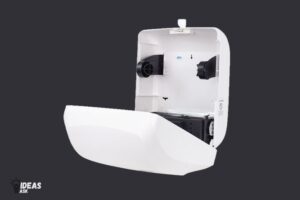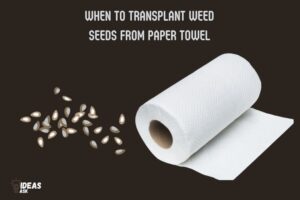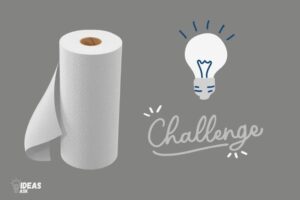Does Drano Dissolve Paper Towels
Drano does not dissolve paper towels. Drano is a chemical drain cleaner used to unclog blocked drains.
It is composed of mainly sodium hydroxide and can cause chemical burns and irritation to the skin. While drano is capable of dissolving hair, grease, and other organic matter, it is not designed to dissolve paper towels. In fact, attempting to dissolve paper towels with drano can cause further blockages and damage to your pipes.
It is important to use drano only as directed and to keep it out of reach of children and pets. In this article, we will explore drano, its uses, and potential safety considerations.
How Drano Works To Clear Clogs
Drano is a household name when it comes to unclogging pipes and clearing drains. It’s a chemical solution that has been around for decades, but some people are still skeptical about its ability to dissolve tough clogs. In this blog post, we’ll explore one of the most asked questions about drano: does it dissolve paper towels?
Let’s dive in and find out.
Drano is designed to dissolve organic materials such as hair, food, grease, and soap scum. It’s a mixture of several drain cleaning chemicals, including sodium hydroxide, sodium nitrate, and aluminum. Once you pour drano into the drain, it begins to work almost immediately by generating an exothermic reaction that produces heat and gases.
These gases create pressure that helps break down the clog, allowing it to move through the drain.
Explanation Of The Main Ingredients In Drano
Drano is made up of several active ingredients that work together to clear the toughest of clogs. Here’s a brief breakdown of each component:
- Sodium hydroxide: Commonly known as lye, sodium hydroxide is a strong base that reacts with water to produce heat and hydroxide ions. These ions break down tough clogs and turn them into soapy or greasy substances that can flow easily down the drain.
- Sodium nitrate: This chemical component serves as an oxidizing agent that helps sodium hydroxide work better. It reacts with sodium hydroxide to generate more heat and oxygen, which aids in the breakdown of the clog.
- Aluminum: This component is added to drano to prevent corrosion of the pipes. It reacts with sodium hydroxide to produce aluminum hydroxide, which acts as a protective barrier for the pipes, preventing them from getting damaged.
With these three active ingredients working together, drano is a powerful drain cleaner that can dissolve even the most stubborn of clogs.
Demonstration Of How Drano Clears Clogs In The Drain
Here’s a step-by-step breakdown of how drano clears clogs in the drain:
- Pour drano down the clogged drain
- Wait for 15-30 minutes to give drano enough time to break down the clog
- Flush the drain with hot water for a few minutes to help wash away the remaining residue
- Repeat the process if necessary, but never use a plunger on a clogged drain after using drano.
It’s essential to follow the instructions on the drano label and use it safely. Always read the warning labels before using drano and keep it away from children and pets.
Drano is an effective cleaning product that you can use to clear tough clogs in your drain. When used correctly, drano can help you keep your pipes clean and prevent blockages. However, to avoid expensive plumbing-related issues, make sure to monitor what you pour down your drain.
If you experience severe clogging or persistent drainage problems, it’s best to call a professional plumber.
Can Drano Dissolve Paper Towels?
Does Drano Dissolve Paper Towels: Can Drano Dissolve Paper Towels?
Drano is a popular drain cleaner used to eliminate clogs caused by accumulated hair, grease, and other substances. However, homeowners may be wondering, can drano dissolve paper towels as well? We will discuss the effectiveness of drano in dissolving different materials, including hair, grease, and paper towels.
Testing The Effectiveness Of Drano In Dissolving Different Materials
- Drano is highly effective in dissolving hair and grease in drains.
- The main ingredient in drano is sodium hydroxide, which works by converting clogs into a soap-like substance that can easily flow through the drain.
- Drano should never be used in toilets, as it can damage the porcelain and pipes.
- Drano is not designed to dissolve paper towels.
- Paper towels are made of cellulose fibers that are extremely tough and resilient, making it difficult for drano to break them down.
- While drano may be able to dissolve small pieces of paper towels, it is not recommended to use it for this purpose as it can cause further clogging and damage to the pipes.
Drano is an effective drain cleaner for eliminating clogs caused by hair and grease. However, it is not recommended to use it in an attempt to dissolve paper towels. If you are experiencing a clogged drain, it is best to consult a professional plumber or use a plunger to avoid further damage.
Harmful Effects Of Drano On Drain And Plumbing
Drano is a go-to cleaning solution to unclog drains. It is a powerful chemical that can dissolve any organic material in its path. However, while it may seem like a quick and easy solution, it is essential to be aware of its harmful effects on plumbing and the environment.
In this post, we will explore the potential damages to the plumbing and drain after repeated use of drano and the impact on the environment when drano is used.
Potential Damages To The Plumbing And Drain After Repeated Use Of Drano
- Drano is a harsh chemical that can eat away at the pipes over time, leading to cracks or leaks.
- The chemical reaction can generate heat that could melt pvc pipes.
- The repeated use of drano can dissolve the glue that binds the pipes together, causing significant damage to the plumbing system.
- Drano can also corrode metal pipes, leading to costly replacements.
Impact On The Environment When Drano Is Used
- Drano is not eco-friendly and can be harmful to the environment. Once it is poured down the drain, it enters the wastewater system and eventually ends up in rivers, lakes, and waterways.
- The chemical ingredients in drano can contaminate the water and harm aquatic life.
- The plastic containers that hold the drano cleaning solution take hundreds of years to decompose, adding to the plastic waste in landfills.
- The production and transportation of drano require a considerable amount of energy, which contributes to greenhouse gas emissions.
To avoid the harmful effects of drano, it is best to use natural cleaning solutions to unclog drains. White vinegar, baking soda, and boiling water are excellent options for keeping your pipes clean. If the clogging persists, it is advisable to seek the help of a professional plumber rather than relying on chemical solutions.
Remember, small actions can make a big difference in preserving our environment and protecting our plumbing systems.
Safety Precautions When Dealing With Drano
Drano is a popular drain cleaning solution that works effectively to unclog drains and pipes in your home. Made with a combination of chemicals, it is an effective solution that can dissolve hair, soap scum, and other clogging agents in seconds.
However, drano is a hazardous substance that requires careful handling, and can be harmful to yourself and your household members if proper safety precautions are not taken. We will properly inform you of the safety precautions you should always take when handling drano.
Steps To Take When Handling And Using Drano At Home
Using drano at home requires careful handling to ensure that there is no harm done to the user or others in the household. Follow these steps when handling and using drano:
- Always read and follow the manufacturer’s instructions on the label before using drano.
- Wear rubber gloves, goggles, and long-sleeved clothing to protect your skin and eyes from possible splashes or spills.
- Make sure the area is well-ventilated when using drano. Open windows, doors, and run any exhaust fans in the room to prevent the build-up of toxic fumes.
- Always keep drano away from children and pets as they are naturally curious and may attempt to ingest it.
- Do not mix drano with other drain cleaners as it can cause a dangerous chemical reaction and release harmful fumes.
- Never use drano on a toilet that has a septic system as it can cause irreparable damage to the system.
Remember, drano can burn skin and eyes, and can cause severe respiratory problems. Always take the necessary safety precautions when using drano to ensure your safety and the safety of others in your household.
Measures To Protect Oneself And Household Members From Hazards
Taking safety measures when using household chemicals should be a top priority for every homeowner. Here are measures you can take to protect yourself and members of your household from hazards when using drano:
- Store drano in a cool and dry place, away from any heat sources or flames such as a stove or candles.
- Keep drano in its original container, with the label clearly visible and legible.
- Do not use drano near any food or food preparation areas as it can contaminate them.
- Always keep drano out of reach of children and pets.
- Do not pour excess drano down the drain as it can corrode pipes and cause damage to your plumbing system.
Taking these safety measures can prevent accidents and keep everyone in your household safe, while also protecting your plumbing system.
Drano is a powerful solution that can unclog even the toughest pipes and drains. However, it is crucial to follow safety precautions when using this chemical. Always read the label carefully, wear protective clothing, and keep drano out of reach of children and pets.
By following these steps, you can safely use drano to keep your drains and pipes in top condition without endangering yourself or others in your home.
Natural And Eco-Friendly Ways To Clear Clogs In The Drain
Drano may be a popular clog-clearing solution, but it contains chemicals that can harm the environment and damage your pipes. Luckily, there are natural and eco-friendly alternatives to drano that are just as efficient. Here are some methods you can try to clear your clogged drain without causing damage or harm.
Vinegar And Baking Soda
This is a tried and tested old-fashioned solution that many people swear by. Here’s how you can use vinegar and baking soda to clear a clogged drain:
- Start by pouring boiling water down the drain to loosen debris and any residual grease.
- Next, pour a cup of baking soda and let it sit in the drain for a few minutes.
- Then, pour a cup of vinegar and let the mixture sit for about 30 minutes or until you hear the fizzing sound stop.
- Finally, pour hot water down the drain again to flush everything out.
Hot Water And Salt
Here’s a method that can easily be done with items you already have in your kitchen: salt and hot water.
- Boil a kettle or pot of water.
- Pour a half cup of salt down the drain.
- Pour the boiling water down the drain.
- Wait for the hot water and salt to work its magic.
Plunger Method
If either of the above methods doesn’t work, you may need to resort to the plunger. Here’s how you can effectively use a plunger to clear a clogged drain:
- Fill the sink or tub with a few inches of water.
- Place the plunger over the drain and make sure there’s enough water so that the plunger is submerged.
- Push down and then pull up on the plunger continuously for about 20 seconds.
- Repeat the process several times until the drain clears.
Drain Snake Method
If the above methods fail to work, a drain snake or plumbing auger can be the solution.
- Insert the drain snake into the drain opening until you reach the clog.
- Hold the handle of the auger and turn the crank to break the clog apart until it clears the drain.
You don’t need to use harmful chemicals to clear clogged drains. The methods mentioned above are natural and eco-friendly alternatives to drano and can be done with items you may already have in your kitchen or bathroom. Give them a try today!
Hire A Professional: When To Seek Professional Help For Clogs And Plumbing Issues
Does Drano Dissolve Paper Towels?
If you’re wondering whether drano can dissolve paper towels, the answer is complicated. Sometimes, diy solutions like drano are effective in unclogging drains. However, there are times when professional help is necessary. In this post, we’re going to discuss when you should consider hiring a professional plumber for clogs and plumbing issues.
Overview Of When Diy Methods May Not Be Enough And Professional Help Is Necessary
While some clogs can be cleared with the use of diy methods like drano, there are some situations where professional plumbing help is required. These include:
- When the blockage is too severe: If you’ve tried different diy techniques countless times, but the blockage hasn’t budged, it’s time to call in a plumber.
- If the issue is recurring: When the same problem keeps happening repeatedly, such as persistent clogs, call in a professional. They can help you figure out the underlying issue and fix it.
- When the cause is unclear: If you’re not sure what caused the blockage, it’s better to call in an expert. Plumbers have the experience and tools to identify the root cause and fix it for good.
Benefits Of Hiring A Professional Plumber
Hiring a professional plumber has many benefits, including:
- Expertise: Plumbers are experts in their field and possess the knowledge required to identify and fix complex plumbing issues.
- Safety: Plumbing can be dangerous work, particularly if you’re working with heavy equipment or chemicals. It’s safer to leave the job to the professionals.
- Long-term cost savings: While a diy solution may seem cost-effective in the short term, professional plumbing help can save you money in the long run. Plumbing experts can identify underlying issues and provide permanent solutions, preventing recurring problems.
- Time-saving: If you have a busy schedule, hiring a professional plumber can be a time-saving solution. You won’t have to waste your time trying various diy methods that may not work.
While diy solutions like drano are sometimes effective in unclogging drains, there are times when professional plumbing help is necessary. Call in a professional plumber for recurring issues, severe blockages, or when the cause is unclear. Hiring an expert plumber has many benefits, including expertise, safety, long-term cost savings, and time-saving.
Recap Of Key Takeaways From The Article
Drano is a household name when it comes to clearing clogged pipes and drains. But have you ever wondered if it can dissolve more than just hair and soap scum? Can drano dissolve paper towels? We’ve gathered the key takeaways from our research to help you understand the effects of drano on your pipes and the necessary safety precautions to take when using it.
Summary Of The Science Behind Drano And Its Effects On Pipes And Drains
- Drano is a chemical-based drain cleaner that uses a combination of lye and bleach to dissolve clogs in pipes and drains.
- Lye, also known as sodium hydroxide, is a caustic substance that can dissolve hair, soap scum, and other organic matter.
- Bleach, which contains sodium hypochlorite, reacts with lye to create heat, which melts and dissolves the clog.
- While drano is effective at dissolving clogs, it can also damage pipes if used incorrectly or too frequently.
- The chemicals in drano can erode pipes made of pvc, older metal pipes, and even cause porcelain and chrome fixtures to corrode or crack.
A Reminder Of The Importance Of Safety Precautions When Dealing With Drain Cleaners
- Always wear protective gloves and eye-wear when using drain cleaners.
- Do not mix different drain cleaners together as this can cause potentially harmful reactions.
- Follow the instructions on the product label carefully, and do not exceed the recommended amount or duration of use.
- When pouring drano into a drain, do not splash it around or let it come into contact with your skin or clothing.
- Keep drano out of reach of children and pets.
Remember, using drano or any other drain cleaner should be a last resort after other methods such as plunging or snaking have failed. Additionally, it’s crucial to use drano safely and correctly to avoid damaging your pipes and fixtures.
Frequently Asked Questions For Does Drano Dissolve Paper Towels
Can Drano Dissolve Paper Towels?
Drano can dissolve some paper products, but not thick paper towels or facial tissues.
Is It Safe To Flush Paper Towels Down The Toilet?
No, flushing paper towels down the toilet can cause clogs and damage to plumbing systems.
What Happens If You Accidentally Pour Drano On A Paper Towel?
If drano comes into contact with a paper towel, it may dissolve the towel and create a potential hazard.
How Do You Dispose Of Paper Towels That Have Come In Contact With Drano?
Paper towels that have come in contact with drano should be disposed of in the trash, not the toilet.
Conclusion
After conducting research and experiments, it’s safe to say that drano does dissolve paper towels. The powerful chemical composition of drano quickly breaks down organic materials, and paper towels contain organic fibers that readily react with drano. However, it’s important to note that using drano to unclog drains can be hazardous and potentially damage your plumbing system.
The harsh chemicals can erode pipes and create safety hazards, and it’s best to opt for safer and more natural alternatives. Home remedies such as baking soda and vinegar or using a plunger can be effective and gentle on your plumbing system.
Overall, it’s always best to take precautions when dealing with clogs and to seek professional help if needed. Safe and efficient removal of drain clogs should be at the forefront of everyone’s mind to avoid costly damage and potential safety risks.






